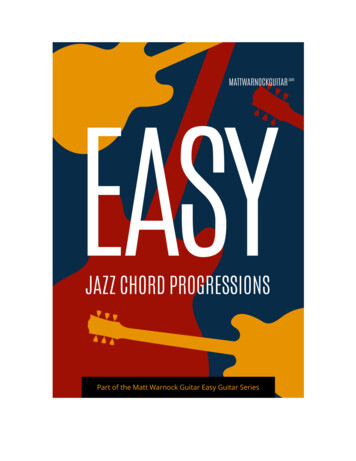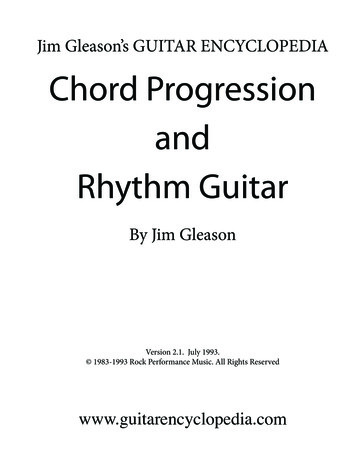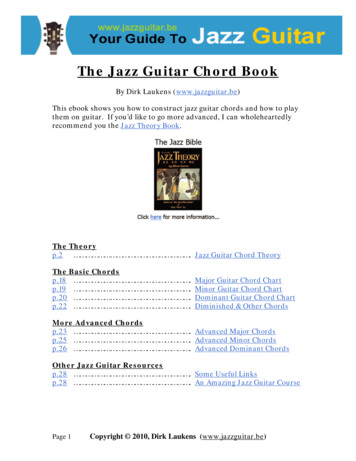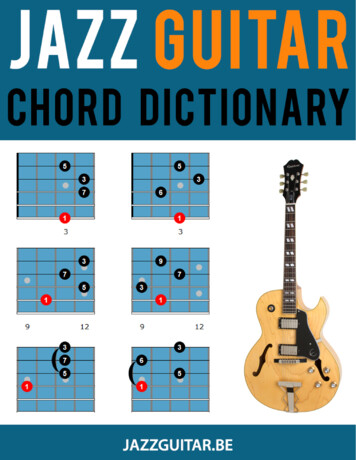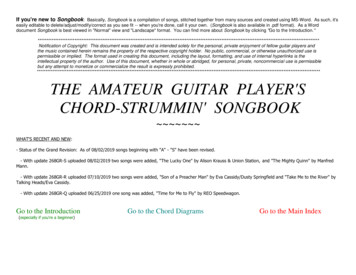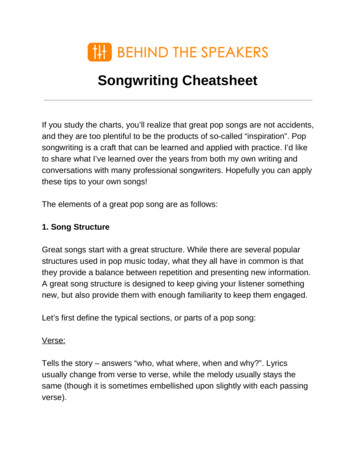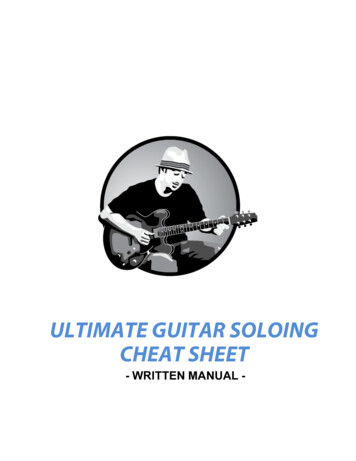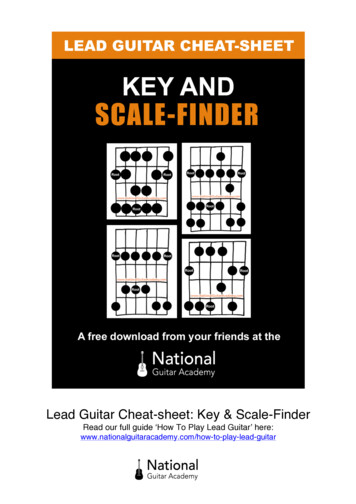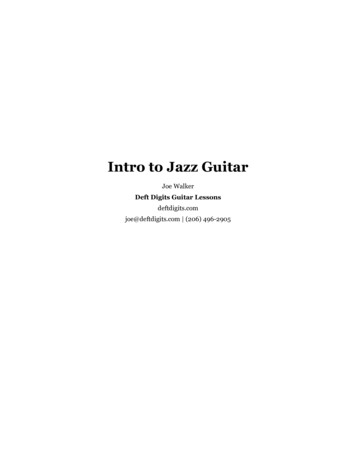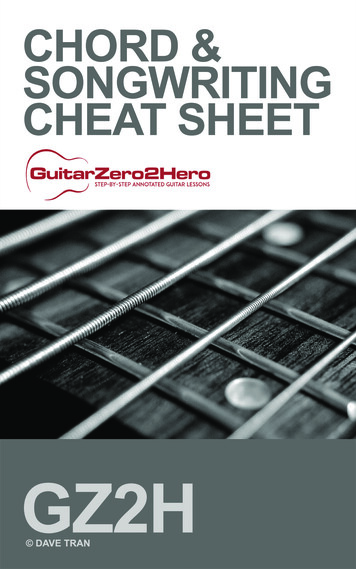
Transcription
CHORD &SONGWRITINGCHEAT SHEET1563 X 2500GZ2H DAVE TRAN
CHORD & SONGWRITING CHEAT SHEETCONTENTSCHAPTER 1 - INTRODUCTIONCHAPTER 2 - CHORD CHARTSCHAPTER 3 - SONGWRITING CHEAT SHEETSCHAPTER 4 - CONCLUSION 2016 GuitarZero2Hero - Dave TranAll rights reserved. No part of this publication may be reproduced, distributed, or transmitted in any form or by any means, including photocopying, recording, or other electronic or mechanical methods, without the prior written permission of the publisher, except in the case of brief quotations embodied in critical reviews and certain other noncommercial uses permitted bycopyright law. For permission requests, write to the publisher, addressed “Attention: Permissions Coordinator,” at the following email address - info@guitarzero2hero.comi
C HAPTER 1IntroductionAn overview and introduction to this comprehensive eBook and aguide to the chord chart notation contained within this eBook. What’s In This eBook? Chord Chart Notation2
WHAT ’ S IN THIS EBOOK ?What’s In This eBook?Welcome to your very own Guitar Chord & Songwriting Cheat sheet.“Success is like a snowball. It takes momentumIn this extremely handy and helpful value packed eBook, I’ll provide you withthe most useful, beautiful, easy and straight-forward guitar chord chartsavailable anywhere. This valuable eBook will not only introduce you to 100’sof the most useful and common guitar chords in existence, but it will alsoguide you in knowing which chords to use together to create professionallyflowing songwriting structures.The best part is that you don’t need to understand the encyclopedia ofmusic theory to begin implementing these techniques.Don’t get me wrong, I am a massive advocate for music theory knowledgeand how much it can enhance your overall creativity and playing ability.However, I am also a bigger believer in kinesthetic learning, otherwise knownas learning by “doing”. Wouldn’t you have so much more fun actually playingcool chord progressions and experimenting with what sounds cool asopposed to studying why it is the way it is on paper?I know personally for myself when I was learning that this was the case. Selfexperimentation, learning my favorite songs from my favorite artists andstudying how they structured their chords in songs was a massive part of myguitar journey. I eventually learnt the musical theory behind everything whichI still highly recommend. But just playing, experimenting and learning myfavorite riffs was by far, a much more rewarding and encouraging activity forme as a guitarist and provided me with one of the most important thingswhen learning anything - Momentum.to build and the more you roll in the rightdirection, the bigger it gets.”Whether you’re a beginner, intermediate or advanced guitar player, theGuitarZero2Hero Chord & Songwriting Cheat Sheet will provide youwith the tools to create an endless collection of chord progressions andsongs.So what’s inside this Chord & Songwriting Cheat Sheet?CHORD CHARTS The Beginner Guitar Hero’s Essential Chord Chart Movable Power Chords Chart Movable Chord Shapes Chart The Ultimate Chord LibrarySONGWRITING CHEAT SHEETS Major Songwriting Chord Maps In 7 Different Keys Minor Songwriting Chord Maps In 7 Different Keys3
CHORD CHART NOTATIONChord Chart NotationFor new beginners out there, reading a chord chart might look like just a bunch oflines and circles, thankfully reading a chord chart is not very difficult at all!There’s just a few different things we need to keep in mind when reading chordcharts.Let’s start with finger positioning - Each finger on your fretting hand is assigned anumber/letter. This is the same regardless of whether you are fretting the guitarwith your left or right hand.Any circle with a number/letter designation on a chord chart simply means you willneed to push that particular string down on that particular fret with the designatedfinger. Figure 1. Fretting Hand Finger Designations1 - Index finger.2 - Middle Finger.3 - Ring Finger.4 - Pinky Finger.T - Thumb.Visually, the chord charts shown in this eBook are a visual representation of 5 fretsof a guitar neck standing vertically as shown in Figure 2.Therefore from left to right we have the thickest strings to thinnest stringsrespectively. Simple!Low EFigure 2. Guitar NeckADGB High eFigure 3. Blank Chord Chart4
CHORD CHART NOTATIONChord Chart NotationFigures 4 and 5 show examples of chord charts that we will see later on in thiseBook. These charts have been annotated with the red arrows to further explainwhat the different parts of the chord chart mean.The main items to note: An open circle above a string means that the open string should be played in thatchord. Do not mute it or push down on any fret of that string. A cross above a string means that we do not play this string in that particularchord. The thick black line at the top of the chord chart in Figure 4 represents the nutof the guitar neck. Figure 5 does not have this black line, meaning that this chordshape is further up the guitar neck. The “4f” note next to the chart chart in Figure 5 means that this chord shapebegins at the 4th fret. The thick white bar across Figure 5 indicates a barre chord - hold down allstrings along the white bar with the finger given in the white circles (for thisexample hold down 5 strings starting from the low A string on the 4th fret usingthe index finger)Do not play this stringPlay this string openNut of the guitarHold down the 3rdfret of the A stringusing your ring fingerCmajorChord nameFigure 4. Cmajor Chord ExampleBarre these stringswith your index finger4th fretThe concludes everything you need to know in order to be able to read a chordchart!C#minorFigure 5. C#minor Chord Example5
CHORD CHART NOTATIONChord Chart NotationFinally to avoid any confusion, we will run through some common abbreviationsyou may come across when reading chords across different publications.In this ebook we will provide full names underneath each chord shape to reallyemphasize and help you learn the chord variants.Below are the most common chord abbreviations.AAmAm7Amaj7A dimLetter by itself - no suffixm suffixm7 suffixmaj7 suffixdim suffixA augaug suffixA MajorMajor ChordA minorA minor7A Major7A A diminishedminor Chordminor 7 Chordminor 7 Chorddiminished ChordA A augmentedaugmented Chord6
C HAPTER 2Chord ChartsThe most useful set of Guitar Chord Charts available! The Beginner Guitar Hero’s Essential Chord ChartMovable Power Chord Shapes ChartMovable Barre Chord Shapes ChartThe Ultimate Chord Library7
THE BEGINNER GUITAR HERO ’ S ESSENTIAL CHORD CHARTThe Beginner Guitar Hero’s Essential Chord ChartThe chord chart on the following page provides you with the 16 most essentialchords shapes that EVERY guitarist should know, along with real life photo’s of howthey should look. These are the chords that over my 14 years of playing andteaching experience appear in more songs than any other chords.If you’re a beginner, study this, print it out, stick it on your bathroom door, stick itbeside your bed, stick it on your fridge door, hell stick it anywhere you’ll be able tosee it daily! There will be 2 versions of these charts The first with photos The second without photosOnce you’ve learnt the 16 chords on the next page you’ve basically learnt theguitar chord shapes used in roughly 60-80% of any song you’ve ever heard!Want proof? If you’ve watched my YouTube video tutorials, you’ll notice that90-95% of the songs I teach use the chords on the next page with the use of acapo.Pretty amazing when you think about it isn’t it? That’s some pretty good bang foryour buck if you ask me!8
THE BEGINNER GUITAR HERO ’ S ESSENTIAL CHORD CHARTA MajorA7A minorA minor7B7B minorC MajorC add9D MajorD minorD sus2D sus4E MajorE minorF MajorG Major9
THE BEGINNER GUITAR HERO ’ S ESSENTIAL CHORD CHARTA MajorA7C MajorD sus2A minorC add9D sus4E MajorA minor7B7D MajorE minorB minorD minorF MajorG Major10
MOVABLE POWER CHORD SHAPES CHARTMovable Power Chord Shapes ChartWhat are power chords you may ask? Power chords are perhaps the mostcommon chord shape used in contemporary rock and roll. Name any famous rockband or rock song and more likely than not, they will feature a power chordsomewhere. Bands like Blink 182, Greenday, Guns N’ Roses & Metallica have themajority of their songs played with power chords.Musically speaking, power chords are abbreviations of full chords, or in other words- a shortened version of a chord which typically consists of 3 or more simultaneousnotes. They contain the root note, which identifies the name of the power chord,and the 5th note in the scale above the root note. It for this reason that powerchords are formally known as 5 chords (for example - a C5 chord).The beauty of the power chord is that they are incredibly easy to play, areextremely versatile and sound especially awesome in rock music. Learning how toplay these is ESSENTIAL for any guitarist, so don’t skip out on this next chordchart.The reason why they sound so great in rock music and are used so widely in thisgenre probably has something to with how open chords consisting of 5 or 6 stringssound with distortion - try it! It doesn’t sound awful, but it does sound rathermessy.Now try play a power chord with distortion and you will notice that it soundstight, focused, purposeful and powerful.There are 2 power chord shapes that we can use. The choice of which to use is amatter of personal preference as they both essentially achieve the same thing.Let’s review the 2 power chord shapes found on the next page.Power Chord Shape 1 Contains 2 notes. The root note The 5th above the root notePower Chord Shape II Contains 3 notes. The root note The 5th above the root note The octave above the root noteAs you can see from below, Power chord shape II is an extension of Power ChordShape I and simply provides a fuller sound when played, but harmonically speakingwon’t sound all that different.Root note - Determines thename of the power chordThe 5th above the root noteThe power chord chart on the following page provides you an easy visual guide toplaying any power chord!The following chord chart is another excellent resource to print out and havehandy and stuck around anywhere you can see it. It’s also a great way to learn someof the notes on the guitar.The Octave above the root noteFigure 6. Power Chord Shape IFigure 7. Power Chord Shape II11
MOVABLE POWER CHORD SHAPES CHARTPOWER CHORD SHAPE 1ISOLUTION 3SOLUTION 4SOLUTION 2ROOT NOTE ON 5TH STRINGSOLUTION 1ROOT NOTE ON 6TH STRINGPOWER CHORD SHAPE 1STEP 1STEP 2STEP 3 Determine what power chord youneed to play. Find the note on 6th or 5th string ofthe fretboard. Locate the root note for the F# power chord and useyour index finger to position your power chordshape. Depending on the shape you want to play (1 or II) placeyour other fingers relative to the power chord root note. Make sure to only pluck the notes you’re pushing downwith your fretting hand.Example - F# Power ChordExample - For F# Power Chord 2, there are 2options 2nd Fret of the 6th string 9th Fret of the 5th stringExample - F# Power Chord See the 4 possible solutions above! They are all correct. What you chooseis a matter of preference.12
MOVABLE POWER CHORD SHAPES CHARTMovable Barre Chord Shapes ChartBarre chords are essential to a developing guitarists’ chord arsenal. Barre chordsare given their name from the way in which they are fretted - by having one ormore fingers pressing down across multiple strings on the same fret. Thisresembles a rigid “bar” that presses down on the strings - hence the term “BarreChord”. If you’re wondering “why the strange spelling?”, well that’s because thespecific spelling “barre” comes from latin-Spanish, as the guitar originated fromSpain.In contrast to power chords, barre chords contain more notes in their compositionand therefore provide more specific voicings. With power chords, if you were tostrike a power chord by itself with no context (not in a chord progression), itwould neither be minor or major. With barre chords we are able to be moreintentional with what we play and we’re able to add more depth and color to ourchord.When do we use barre chords? Well, barre chords are typically used for morecomplex voicings and for when we are playing in keys that are not suited to basicopen chords. The beauty of barre chords are that their shapes are movable anduniversal!If you look closely at the movable barre chord shapes on the next page, you willnotice that the first two notes of every barre chord shape are power chords ifplayed just by themselves! That’s why you should consider barre chords as the“extension” or “add-on” of the power chord - think of it as the bells and whistles ofthe power chord. It goes without saying, but prior to learning barre chords, youshould be able to play power chords. If you can’t play a power chord properly thenthere will be a low chance you will be able to play a barre chord. Make sure yourfoundations are sound. Similar to power chords, we will base the root note ofbarre chords off either the 6th (E) or 5th (A) string of the guitar.The following movable barre chords chart will provide you with 12 barre chordshapes which will allow you to play hundreds of chord variations, how neat is that?!The one thing all the barre chord shapes have in common is that their name isdictated by their root note or the lowest note that your index finger plays. Thissystem is similar to what we encountered with power chords.The other thing the following barre chord shapes have in common is that they areall barred with the index finger. No exceptions!With over a decade of teaching experience, barre chords are often a big hurdle forbeginner guitarists, but as I will always say - with practice, patience and persistence,anyone can play barre chords (even if you have small hands!). At the core, barrechords are very basic, however beginner guitarists will oft
GuitarZero2Hero Chord & Songwriting Cheat Sheet will provide you with the tools to create an endless collection of chord progressions and songs. So what’s inside this Chord & Songwriting Cheat Sheet? CHORD CHARTS The Beginner Guitar Hero’s Essential Chord Chart Movable Power Chords Chart Movable Chord Shapes Chart


